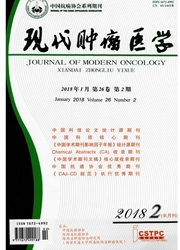

 中文摘要:
中文摘要:
目的:研究P13K/AKT/mTOR通路在乳腺癌细胞FASN过表达中的作用,研究抑制该通路能否协同FASN抑制剂发挥靶向抗肿瘤作用。方法:荧光素酶检测法检测mTOR抑制剂rapamycin对乳腺癌细胞FASN转录活性的影响。Westernblotting检测P13K抑制剂LY294002及rapamycin对乳腺癌细胞AKT、pAKT、mTOR通路成员以及FASN的表达影响。分别给予乳腺癌细胞FASN抑制剂cerulenin、rapamycin及两者联合给药,MTT法检测不同干预法对细胞存活的影响。结果:Rapamycin可明显降低乳腺癌细胞FASN启动子活性,其中在FASN过表达的SKBR3细胞中最明显。LY294002作用后pAKT、pmTOR、FASN的表达均明显降低。Ra-pamycin作用后mTOR、pmTOR、p4EBP-1、pp70S6K及FASN的表达均明显下调。Cerulenin可对乳腺癌细胞产生细胞毒作用,在SKBR3中更显著。Rapamycin对乳腺癌细胞的细胞毒作用与FASN的表达无关。Rapam—ycin能够协同cerulenin对乳腺癌细胞产生细胞毒作用,且在SKBR3细胞中更明显,小剂量rapamycin联合小剂量cerulenin即达到较大细胞毒作用。结论:P13K/AKT/mTOR通路参与调控乳腺癌细胞FASN的过表达,mTOR通路抑制剂联合FASN抑制剂有望成为高侵袭性乳腺癌新的治疗方法。
 英文摘要:
英文摘要:
Objective:To investigate the molecular mechanism of PI3K/AKT/mTOR pathway regulating the over- expression of fatty acid synthase (FASN) in breast cancer in order to realize its upstream signal pathway, and study if inhibition of this pathway combined with FASN inhibitor could induce synergetic cytotoxic effect. Methods : To ana- lyze the effects of mammalian target of rapamycin (mTOR) inhibitor rapamycin on FASN transcriptional activities in three breast cancer cells with different FASN abundance by luciferase assay. To detect the expression of AKT, phos- phorylation of AKT (pAKT), mTOR pathway members and FASN in the three breast cancer cells treated with PI3K inhibitor LY294002 and mTOR inhibitor rapamycin by Western blotting. To analyze the cytotoxic effect of FASN in- hibitor cerulenin combined with rapamycin on breast cancer cells by MTF assay. Results:Luciferase assay showed the transcriptional activities of the three breast cancer cells were obviously decreased treated with rapamycin especially in FASN overexpressed SKBR3 cell line. Western blotting assay showed the expression of pAKT, phosphorylation of mTOR (pmTOR) and FASN were evidently decreased treated with LY294002 in three breast cancer cells, while the expression of constitutive AKT and mTOR showed no evident change. As wells as FASN, the expression of mTOR, pmTOR and its downstream members phosphorylation of 4EBP - 1 ( p4EBP - 1 ), phosphorylation of p70S6K (pp70S6K) in the three breast cancer cells were all evidently decreased treated with rapamycin. Cell proliferation as- say showed that cerulenin could induce effective cytotoxic 'effects on the three breast cancer cells especially in FASN overexpressed SKBR3 cells. The cytotoxic effects of rapamycin had no relationship with the abundance of FASN in the three breast cancer ceils. Rapamycin could induce synergetic cytotoxic effect combined with cerulenin in breast canc- er cells especially in FASN overexpressed cells. Low dose rapamycin combined with low dose ceru
 同期刊论文项目
同期刊论文项目
 同项目期刊论文
同项目期刊论文
 期刊信息
期刊信息
